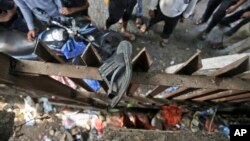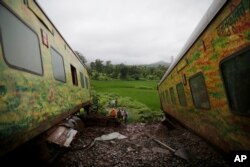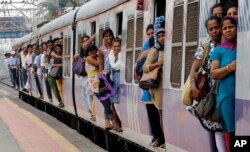Heavy rain along with unfounded rumors about a pedestrian bridge collapse are being blamed for last month's deadly stampede that killed 23 people at a rail station in Mumbai, India.
In aftermath of the fatal crush on September 29, there are loud calls to fix the creaking and overcrowded local rail network on which 7.5 million people ride every day and which claims more than 3,000 lives each year — sometimes due to falls from packed trains.
An official report into the stampede said it was triggered by similar sounding words in Hindi. A vendor shouted "phool gir gaya" (flowers had fallen), fanning the rumors that "pul gir gaya" (the bridge is collapsing). Panic ensued as the crowd on the footbridge surged when people sought shelter from the downpour.
The report, issued Wednesday, has triggered a public outcry over laying blame for the tragedy at the door of weather and rumors, and failing to acknowledge the bridge was too narrow and dilapidated to handle the vast numbers that cross it daily.
"It was going to happen," said Samir Zaveri, a rail activist, who has been campaigning for 25 years to improve safety on Mumbai's suburban network. He pointed to the surge in commuters at the Prabhadevi station since a gleaming, high-rise office complex sprung up in its vicinity in recent years.
"This has not happened suddenly that a huge crowd came," he said "It was there daily."
Tweets from several commuters had warned about such a possibility even before the stampede.
The tragedy has turned the spotlight on a lack of safety standards across the rail network in Mumbai, India's wealthiest city and home to thousands of millionaires.
The bridge where the stampede occurred is not the only one that commuters dread crossing. Much of the rail infrastructure is badly worn down and grossly inadequate to handle the numbers during peak hours when passengers hanging out precariously from trains is a common sight.
Dr. Akanksha Tripathi crisscrosses the rail network several times a day. Her biggest challenge, she said, is the daily struggle to squeeze into and get off the packed trains and cross bridges at stations.
"If both trains come together, there is lots of crowd, people keep on pushing each other," she said. But like millions of others, she has little choice — it is the cheapest and fastest mode of travel across the city.
"I have to face the situation, which is a bit worrisome," she said. Her train had passed by Prabhadevi station just minutes before the stampede.
Overcrowding, say experts, is an understatement for the large numbers at peak hours on the rail network.
"It is already in conditions of extreme crowding, hyper dense, densities are at a point where you have to get into crowd management," said Madhav Pai, director of the research group WRI India Ross Center (part of WRI Ross Center for Sustainable Cities.)
He said there is an urgent need to improve the flow of people by widening bridges, staircases and platforms at stations.
And although the need for such measures is widely accepted, Pai said, "Implementation is very slow; it is not a priority."
Presenting the report on the stampede, Western Railways spokesman Ravinder Bhakar acknowledged that infrastructure is inadequate. "We have not been able to keep pace with the rate at which traffic is increasing," he said.
He added that rail authorities have set a target to widen 13 bridges and build 10 new ones in about 10 months. But there are widespread complaints that authorities only expedite projects in the wake of tragedies.
And while the stampede made headlines nationally, the death toll so far this year on the suburban network has topped 2,000.
Many people are killed as they fall off trains after losing their footing, or are accidentally pushed as they cling to open doorways. Others die when they cross tracks, sometimes in a rush to catch a train or avoid the crowded footbridges — one more risk that people who live on the margins take without much thought.
Activist Zaveri has been campaigning for years for safety measures, such as building a boundary wall between rail tracks. It's a project close to the heart of a man who lost both legs as he dashed across the tracks when he was 17 years old. He said it has been tough to sensitize officials to passenger safety.
"Today they will die, tomorrow also they will die," he said. "This is India, very little or zero value for life."
The spotlight on the city's shabby train network came two weeks after Prime Minister Narendra Modi inaugurated a $17 billion project to build the country's first bullet train between the western cities of Mumbai and Ahmedabad.
In recent days, thousands in the city have signed an online petition to give priority to improving the network, a lifeline for millions, rather than to projects like the bullet train.









